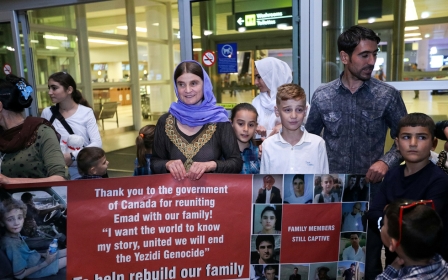Back from hell: The Yazidi women who survived the Islamic State

DUHOK, Iraq - For the last few days, Halima has spent most of her time curled up under a heavy duvet, trying to ward off a chill and the memories of the unspeakable horrors she has seen.
The 21-year-old Yazidi woman is being kept under observation at the psychiatric unit of Duhok’s Azadi Hospital in Iraq's Kurdish region for five days.
"As soon as I close my eyes, I see IS [Islamic State militants] strangling me,” says Halima, her eyes wide open and panicked.
Abducted in August 2014, Halima endured IS's brutal sexual exploitation for three years and five months. Since her release in exchange for a ransom in January, Halima has been staying at the displaced persons camp near Duhok with her parents, where she has been suffering from depression, insomnia and a lack of appetite.
Life as a sex slave
Halima was taken to the Syrian city of Raqqa after she was kidnapped. For one month, she was forced to stay in a brothel belonging to IS.
“I was in a small room, with no windows or lights, drugged by injection or pills,” Halima recalls, adding that different men would rape her on a daily basis. “I could hear other women screaming in the building.”
Her child with an IS fighter is a secret, she can't tell anyone ... If her family finds out, she is afraid of being killed
- Burhan Aldeen Tahir, Iraqi psychologist
On 3 August 2014, IS took over the Sinjar district, a predominantly Yazidi area in northern Iraq. At the time, Halima was a 17-year-old newlywed and had just moved in with her in-laws.
In the following days, approximately 10,000 Yazidis were killed or abducted by IS. Hussein al-Qaidi, the director of the Kidnapped Affairs department at the Kurdistan Regional Government (KRG) told Middle East Eye that this figure included around 3,500 women and girls, who were captured by IS.
Viewed as war booty, many women were forced to marry IS militants or sold on a sex slave market.
Survivors hospitalised in the psychiatric unit of Duhok’s Azadi Hospital find it difficult to carry their traumas and harrowing memories.
Untold trauma
Halima gets up from her bed, clearly in pain. She has an appointment with Iraqi psychologist, Burhan Aldeen Tahir, who is a staff member at the psychiatric unit, in order to draw her "lifeline".
As soon as I close my eyes, I see them strangling me
- Halima
During the session, Halima places flowers - which represent her childhood - on the floor and then proceeds to add a candle, which symbolises her wedding. Then she adds three stones, one for each year spent in IS captivity. Halima also positions several pieces of wood down, each one signifying the public beheadings she witnessed.
After spending one month in the brothel in Raqqa, she was forced to marry an IS fighter from Chechnya and they later had a baby boy.
"I miss my son," Halima says.
The supreme leader of the Yazidis, Khurto Hajji Ismail, who is known as Baba Sheikh, declared in 2014 that Yazidi women who had been enslaved by IS were once again welcome in the community. But nothing similar exists for the children born of rape during IS captivity.
Lack of resources
Every week, "one to two [female] survivors [of the Yazidi genocide] are hospitalised after attempting suicide," says Adnan Asaad Tahir, head of Azadi Hospital’s psychiatric department. “They face lots of traumas,” he says, referring to suicidal tendencies, depression and post-traumatic stress disorder.
Every Tuesday and Thursday morning, other survivors line up at the hospital to receive medical examinations and get prescriptions for sleeping pills. In the sea of faces marked by fear, psychological distress is apparent.
I’m having nightmares and think about my brother, my sister and my dad, who are still detained by IS
- Sara
With a haggard gaze, 28-year-old Sara, another IS victim, is sitting in the consultation room. She was kidnapped in Kojo, a Yazidi village in northern Iraq in August 2014 and was enslaved by IS until November 2015. Sara has trouble sleeping.
“I’m having nightmares and think about my brother, my sister and my dad, who are still detained by IS. I can imagine what they have to endure in captivity,” Sara says.
“Without pills, I can’t sleep,” Sara says.
Sara’s weekly visits to Dr Tahir are not easy, since she lives in the village of Wardiya, which is 175 kilometres away from the hospital.
“I simply can’t afford the transportation costs,” she says. A round trip in a shared taxi costs her around $50.
Sara was forced to marry an IS militant in Tal Afar city, in northwestern Iraq, who mistreated her, but she declined to give details. She was living with her 10-year-old daughter Aziza, who is from a previous marriage to a Yazidi man.
“When I was captive, I tried to escape. But IS caught me and threatened to kill me if I would try again. Later on, some family members paid $6,000 to liberate me,” she says.
According to al-Qaidi, 1,525 Yazidis remain captured by IS in Iraq, Syria and Turkey. A well-established network of smugglers control their release, in exchange for ransom, which can reach several thousands of dollars per person.
I could hear other women screaming in the building
- Halima
However, their needs have been growing over time.
“In the weeks following their release, the women are busy [adapting] to their new daily environment and the medical examinations,” Dr Tahir said. “But once this period is over, they understand that they’ll never return to their homes," and that's when the traumas start to reveal themselves, he says. Most of their homes in Sinjar have been destroyed.
Sinjar, in northwestern Iraq, was the heartland of the Yazidi religious community. Today, it remains a no-man’s land as approximately 70 percent of the buildings have been damaged or destroyed. Only 4,000 of 50,000 families have returned.
“You are much better," concludes Dr Tahir, comforting her at the end of the 45-minute session.
Shivering, Halima stands up and goes back to the room that she shares with another woman and slips under the duvet once again. Tomorrow, she is expected to leave the hospital and return to the displaced persons camp near Duhok and see her parents.
*The names of the survivors interviewed were changed to protect their identitities.
Middle East Eye propose une couverture et une analyse indépendantes et incomparables du Moyen-Orient, de l’Afrique du Nord et d’autres régions du monde. Pour en savoir plus sur la reprise de ce contenu et les frais qui s’appliquent, veuillez remplir ce formulaire [en anglais]. Pour en savoir plus sur MEE, cliquez ici [en anglais].










